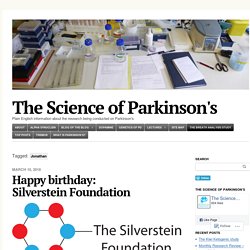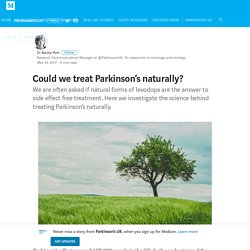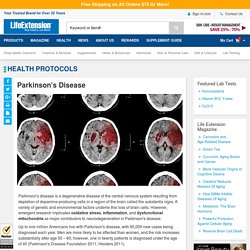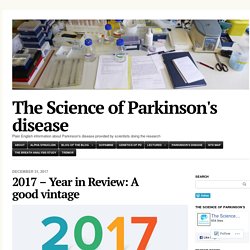

Early Signs and Diagnostics of Parkinson's. Stages of Parkinson's. Exercise for Parkinson's Disease. Alternative Parkinson's Approaches. Medication for Parkinson's. Alzheimer's and Parkinson's Diseases and the Microbiomes. Nutrition and Parkinson's Disease.
Parkinson's Disease. Parkinson's Disease. Parkinson Society Southwestern Ontario. The Science of Parkinson's. Jonathan Silverstein.

Source: Forbes This is Jonathan Silverstein. He’s a dude. He is also a General Partner and a Co-Head of Global Private Equity at OrbiMed – the world’s largest fully dedicated healthcare fund manager. During his time at OrbiMed, the company has invested in healthcare companies that have been involved with over 60 FDA approved products. In February 2017, he was diagnosed with Parkinson’s disease at just 49 years of age.
Rather than simply accepting this diagnosis, however, Mr Silverstein decided to apply the skills that he has built over a long and successful career in funding biotech technology, and in March 2017, he and his wife, Natalie, set up the Silverstein Foundation. They raised $6 million from donors and then provided another $10 million of their own money to fund the endeavour, which has funded a dozen research projects and started a new company called Prevail Therapeutics (we’ll come back to this shortly). Source: Businesswire What is ‘GBA’? Continue reading.
How to Prevent Parkinson’s Disease with Diet and Lifestyle. Parkinson's disease: Boosting dopamine promotes movement. Welcome to Medical News Today Healthline Media, Inc. would like to process and share personal data (e.g., mobile ad id) and data about your use of our site (e.g., content interests) with our third party partners (see a current list) using cookies and similar automatic collection tools in order to a) personalize content and/or offers on our site or other sites, b) communicate with you upon request, and/or c) for additional reasons upon notice and, when applicable, with your consent.

Healthline Media, Inc. is based in and operates this site from the United States. Any data you provide will be primarily stored and processed in the United States, pursuant to the laws of the United States, which may provide lesser privacy protections than European Economic Area countries. By clicking “accept” below, you acknowledge and grant your consent for these activities unless and until you withdraw your consent using our rights request form. Learn more in our Privacy Policy. A cure for Parkinson's? Replacing damaged brain cells shows promise. Welcome to Medical News Today Healthline Media, Inc. would like to process and share personal data (e.g., mobile ad id) and data about your use of our site (e.g., content interests) with our third party partners (see a current list) using cookies and similar automatic collection tools in order to a) personalize content and/or offers on our site or other sites, b) communicate with you upon request, and/or c) for additional reasons upon notice and, when applicable, with your consent.

Healthline Media, Inc. is based in and operates this site from the United States. Any data you provide will be primarily stored and processed in the United States, pursuant to the laws of the United States, which may provide lesser privacy protections than European Economic Area countries. By clicking “accept” below, you acknowledge and grant your consent for these activities unless and until you withdraw your consent using our rights request form. Learn more in our Privacy Policy. Parkinson's: Could this existing drug halt disease progression? Welcome to Medical News Today Healthline Media, Inc. would like to process and share personal data (e.g., mobile ad id) and data about your use of our site (e.g., content interests) with our third party partners (see a current list) using cookies and similar automatic collection tools in order to a) personalize content and/or offers on our site or other sites, b) communicate with you upon request, and/or c) for additional reasons upon notice and, when applicable, with your consent.

Healthline Media, Inc. is based in and operates this site from the United States. Any data you provide will be primarily stored and processed in the United States, pursuant to the laws of the United States, which may provide lesser privacy protections than European Economic Area countries. By clicking “accept” below, you acknowledge and grant your consent for these activities unless and until you withdraw your consent using our rights request form.
Learn more in our Privacy Policy. Atypical Parkinsonism: Diagnosis, symptoms, and treatment. Welcome to Medical News Today Healthline Media, Inc. would like to process and share personal data (e.g., mobile ad id) and data about your use of our site (e.g., content interests) with our third party partners (see a current list) using cookies and similar automatic collection tools in order to a) personalize content and/or offers on our site or other sites, b) communicate with you upon request, and/or c) for additional reasons upon notice and, when applicable, with your consent.

Healthline Media, Inc. is based in and operates this site from the United States. Any data you provide will be primarily stored and processed in the United States, pursuant to the laws of the United States, which may provide lesser privacy protections than European Economic Area countries. By clicking “accept” below, you acknowledge and grant your consent for these activities unless and until you withdraw your consent using our rights request form. Parkinson’s UK. Parkinson's Life. The Michael J. Fox Foundation for Parkinson's Research. Plain English information about Parkinson's disease provided by scientists doing the research. Neurogenic Orthostatic Hypotension - Medical Animation. Parkinson's Foundation: Better Lives. Together. Parkinson's News Today - Parkinson's News Today. International Parkinson and Movement Disorder Society. Could we treat Parkinson’s naturally? – Parkinson’s UK. Parkinson’s affects around 127,000 people in the UK.

In the early stages of the condition many may not need to take medications. But, as the condition progresses, most will turn to medications to help manage its symptoms. Levodopa is the most commonly prescribed drug for Parkinson’s. It works by replacing the dopamine that the brain is no longer making. It is a chemical building-block that the body converts into dopamine, and the ‘active ingredient’ that is found in conventional Parkinson’s medications. Levodopa is very effective, particularly in the early stages of the condition.
Levodopa in medications The levodopa in our medications is man-made. But levodopa can also be found in nature. Life Extension Series. Parkinson's disease is a degenerative disease of the central nervous system resulting from depletion of dopamine-producing cells in a region of the brain called the substantia nigra.

A variety of genetic and environmental factors underlie this loss of brain cells. However, emergent research implicates oxidative stress, inflammation, and dysfunctional mitochondria as major contributors to neurodegeneration in Parkinson's disease. Up to one million Americans live with Parkinson's disease, with 60,000 new cases being diagnosed each year.
Men are more likely to be affected than women, and the risk increases substantially after age 50 – 60; however, one in twenty patients is diagnosed under the age of 40 (Parkinson's Disease Foundation 2011; Heisters 2011). Conventional medical approaches to treating Parkinson's disease aim to replace the lost dopamine, but fall short of addressing the ongoing destruction of dopaminergic neurons. The Science of Parkinson's disease. The number of research reports and clinical trial studies per year since 1817 As everyone in the Parkinson’s community is aware, in 2017 we were observing the 200th anniversary of the first description of the condition by James Parkinson (1817).

But what a lot of people fail to appreciate is how little research was actually done on the condition during the first 180 years of that period. The graphs above highlight the number of Parkinson’s-related research reports published (top graph) and the number of clinical study reports published (bottom graph) during each of the last 200 years (according to the online research search engine Pubmed – as determined by searching for the term “Parkinson’s“).
PLEASE NOTE, however, that of the approximately 97,000 “Parkinson’s“-related research reports published during the last 200 years, just under 74,000 of them have been published in the last 20 years. Parkinson's Symptoms, Causes & Risk Factors. Parkinson’s disease is a chronic, cognitive condition that’s claiming more and more people every year.

Experts now estimate that in the world’s most populated nations, rates of Parkinson’s disease will climb to almost 40 million sufferers by the year 2030. (1) As the world’s population of older adults increases, and people on average live longer than ever before, the number of Parkinson’s patients dealing with Parkinson’s symptoms who are both young and old is expected to reach an all-time high. Some researchers predict that the U.S. alone will spend around $14 billion annually to help treat Parkinson’s patients by the year 2040! And over the course of a lifetime, preventing and stopping disease progression in just one Parkinson’s patient is believed to save the health care system more than $440,000. Luckily, a 2016 study by a team of researchers at the University of Saskatchewan found a possible way to stop the progression of Parkinson’s. Parkinson's disease: A looming pandemic.
Autoimmunity may have role in Parkinson's disease. Basal Ganglia: Function & 15 Disorders Linked to It. New Study Looks at Calcium’s Role in Parkinson’s Disease. New drug target for Parkinson's disease found. Parkinson's breakthrough: New disease-causing mechanism found. Welcome to Medical News Today Healthline Media, Inc. would like to process and share personal data (e.g., mobile ad id) and data about your use of our site (e.g., content interests) with our third party partners (see a current list) using cookies and similar automatic collection tools in order to a) personalize content and/or offers on our site or other sites, b) communicate with you upon request, and/or c) for additional reasons upon notice and, when applicable, with your consent.

Healthline Media, Inc. is based in and operates this site from the United States. Any data you provide will be primarily stored and processed in the United States, pursuant to the laws of the United States, which may provide lesser privacy protections than European Economic Area countries. By clicking “accept” below, you acknowledge and grant your consent for these activities unless and until you withdraw your consent using our rights request form.
Learn more in our Privacy Policy. Possible reasons for loss of smell. Link between Parkinson's and melanoma runs both ways. Power stations in cells may protect brain against Parkinson´s. Caffeine level in blood may help diagnose people with Parkinson's disease. Cancer Drug Enables Parkinson's Patients to Walk Again. The drug nilotinib, which is already approved to treat cancer, appears to also directly target the causes of Parkinson’s disease. “We’ve seen patients at end stages of the disease coming back to life,” says Charbel Moussa of Georgetown University Medical Center in Washington DC, who led the trial. The small safety trial at Georgetown University involved 12 volunteers with Parkinson's Disease, or a similar condition called dementia with Lewy bodies. All the volunteers were at an advanced stage of disease at the start of the trial.
For six months, they were given a daily oral dose of the drug nilotinib, which is already approved in the treatment of leukemia. Nilotinib blocks a protein that drives chronic myeloid leukemia. Seasonal Flu Infection May Increase Risk of Parkinson's. Recent study has provided further evidence supporting the idea that environmental factors, incluidng influenza may be involved in Parkinson's disease. A new study has found the risk of developing Parkinson's Disease is higher in people who have been infected with the seasonal flu. Researchers suspect a particular strain of influenza is responsible for predisposing lab mice to develop disease processes that closely mimic Parkinson's Disease.
Non-Invasive Brain Stimulation. Powering Off Parkinson's Disease. By inserting a metal rod into the brain, scientists have used deep brain stimulation to treat Parkinson's, and this method is being explored for use in Alzheimer's, as well. Medical researchers have found that it is possible to treat Parkinson's by inserting a metal rod directly into the brain. This rod stimulates the brain and alleviates the symptoms of Parkinson's. Researchers believe this treatment might even help those afflicted with Alzheimer's, epilepsy, bipolar disorder and depression. About Deep Brain Stimulation Deep brain stimulation, also referred to with the acronym of "DBS" is intriguing because of its reanimation potential. DBS is typically used on patients where traditional medication does not suffice. If the placement of a metal rod in the brain seems a bit obtrusive or slightly morbid, don't fret.
Another technique referred to as “Neural Lace”, is currently being perfected by a company led by none other than Elon Musk of Tesla Motors fame. Altered Iron Levels in Parkinson's Brains. Iron, which occurs naturally in the human body, distributes itself in an unusual way in people with Parkinson's Disease. Parkinson’s disease affects the neurological functioning of the brain. Researchers are unsure of the causes or underlying mechanisms associated with the disease, but it has been speculated that it is a production of oxidative stress.
Biomarkers for cognitive impairment in Parkinson's revealed. Tracing the path of Parkinson's disease proteins. How protein fragments associated with Alzheimer's could trigger Parkinson's. New drug may treat and limit progression of Parkinson's disease. Commonalities in brains of people with Huntington's disease and Parkinson's disease. Geographic and Ethnic Variation in Parkinson Disease: A Population-Based Study of US Medicare Beneficiaries. Latest PD Researches and Articles - CliniCrowd. Defects in cell’s ‘waste disposal system’ linked to Parkinson’s - CliniCrowd. The unified theory of Parkinson's – Parkinson’s UK. Let’s start by delving deep inside the brain to look inside the cells affected by Parkinson’s — the dopamine producing cells of the substantia nigra . While it is generally recognised that Parkinson’s does not start in these cells, studies of the progression of the condition show its spread from further down the spinal cord and, in some cases, may even originate in the gut, it is their loss that causes the symptoms of the condition.
Over the past few decades, we have learnt a lot about how Parkinson’s impacts on the pathways and distinct parts of these brain cells, and have started to discover what goes wrong leading up to their loss. This is where the first challenge in Parkinson’s appears… “Parkinson’s was once thought to be the easiest of the major neurological disorders to solve. The knowledge of the past 20 years, has been great, but it’s also made the field appreciate just how complex a disorder it is.” — Martin Taylor. Alpha-synuclein in colonic submucosa in early untreated Parkinson's disease - Shannon - 2011 - Movement Disorders. How Parkinson’s wearables can deliver accurate data from patient to neurologist. Resources & Tools sponsored by Global Kinetics Corporation Ltd Author: SponsoredPublished: 24 May 2017 Prep: Cook: Serves: This new video follows patient Fred and his wife Olive as they visit their neurologist to discover the powerful possibilities of the latest wearable technology.
Evaluation of the association between blood homocysteine concentration and the degree of behavioral symptoms in the 6-hydroxydopamine-induced Parki... - PubMed - NCBI. New Research and Treatments for Parkinson’s Disease. Parkinson's is partly an autoimmune disease, study finds: First direct evidence that abnormal protein in Parkinson's disease triggers immune response. PARKINSON'S DISEASE AND CHIROPRACTIC. Solutions for Parkinson's Disease. Spirulina, Chlorella Side Effects May Put You In Wheelchair? Cyanobacteria – also known as blue-green algae – are superfoods that can be hard to avoid these days. Even if you’re not buying the powder, there’s a good chance you’re consuming small amounts of it in other products. It’s added to many high-end protein powders, organic multivitamins, and even used as an ingredient in a popular brand of cookies sold at health food stores in the Los Angeles area.
Spirulina is gluten free, vegan, and an allergy of it is unheard of. Given its widespread appeal and use, you assume it’s safe. Is spirulina good for you… or downright dangerous? If it’s 100% pure, it is safe and offers many nutritional benefits. How bad is this problem? Integrating glutathione metabolism and mitochondrial dysfunction with implications for Parkinson’s disease: A dynamic model.
JavaScript is disabled on your browser.